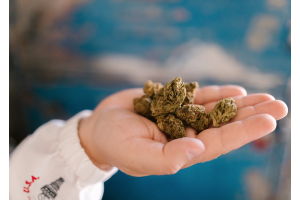Can cannabis help curb the opioid epidemic?

We’ve seen a rise in opioid usage and, more importantly, opioid-related deaths throughout the last few decades.
While researchers aren’t 100% sure what’s causing more people to seek out these substances, some believe it has to do with the rising rates of opioid prescriptions. ¹Simply put, many out there are given opioids for pain relief.
However, most aren’t 100% aware of how addictive these substances can be. In turn, they develop a dependence their doctors will not continue prescribing. And they’ll turn to other opioid drugs (i.e., fentanyl or heroin) to avoid withdrawal. ²One way cannabis may help curb the opioid epidemic is by becoming a new solution for pain management.
As we’ll get into it, there’s lots of evidence to suggest cannabis and various cannabinoids can be used to help manage pain in varying conditions.Furthermore, some research suggests we may even use cannabis as a therapeutic medicine to help those recovering from opioid withdrawal.
Throughout this article, we will take a deeper look at cannabis and how it may help with pain to prevent opioid addiction. From there, we’ll take a look at how cannabis may be able to help those already addicted to opioids. Cannabis for Pain Relief Chronic pain is a common symptom of many health conditions, including cancer, heart disease, and diabetes. Chronic pain is the most common long-term disability experienced by Americans.³Currently, there’s a lot of anecdotal evidence to suggest that cannabis may be able to relieve certain types of pain. Furthermore, certain cannabis strains may be more appropriate for pain than others.
But before we can adequately understand how cannabis can help with pain, it helps to know how cannabis affects the body.By consuming cannabis, we’re ingesting cannabinoids found in the cannabis plant. There are over 100 different cannabinoids, but tetrahydrocannabinol (THC) and cannabidiol (CBD) are the two most common.
When we consume THC, the cannabinoid attaches itself to CB1 receptors in the brain and throughout the body. CB1 receptors are responsible for many regulations, including releasing neurotransmitters, such as serotonin, dopamine, and glutamate.4 Since these receptors play a role in the brain’s reward system, they also affect pain levels.
By stimulating these neurotransmitters, THC can theoretically use the brain’s reward system as a way to reduce the level of pain we feel.5 However, we currently only have so much research backing up this theory:
- In a 2015 review, it was concluded that marijuana and certain cannabinoids could positively affect treating certain types of chronic pain, such as neuropathy (nerve pain).6
- In 2016, a research paper discovered that marijuana consumption led to a 64% reduction in opioid use among cancer patients. This provided people with fewer medication side effects and improved quality of life.7
- A smaller study found that out of 17,000 people struggling with cancer, 70% found marijuana to help improve pain.8
- One study found that people with chronic migraines found relief from migraine episodes through cannabis use.9Unfortunately, cannabis research remains inconclusive. An Australian study found that marijuana use didn’t seem to affect a patient’s pain tolerance or their need for opioid medication.10Still, the research is promising and shows that cannabis has potential. But how does cannabis pain relief compare to opioid pain relief?
Opioids for Pain ReliefAs of this time, opioids remain one of the best drugs for pain relief. This is because they can be designed for both immediate-release and extended-release - allowing for pain relief of different spectrums.
The reason opioids are so effective for pain is because they directly attach themselves to receptors in the brain responsible for pain sensations. This allows opioid drugs to signal to the brain to reduce pain transmission immediately and will enable the consumer to feel a moment of relief. ¹¹One of the biggest difficulties with opioids is side effects. The most common include: ¹²
- Confusion
- Constipation
- Drowsiness
- Impaired judgment
- Increased risk of contracting an infectious disease (if injected through a needle)
- Nausea
- Overdose (sometimes fatal)•Pregnancy loss, low birth weight, or baby developing opioid dependence
- Slower breathing
- Substance abuse disorder
Of course, cannabis also comes with its selection of side effects - the most notable being psychoactivity. But compared to opioids, cannabis side effects are relatively mild, which is why many researchers are looking into it as a potential pain relief treatment. Furthermore, while cannabis can be addictive, it doesn’t hold as much risk as opioids.
While Opioids are Better for Pain Relief, Cannabis Provides Less RisksAs you can see, current research has concluded that opioids remain a better pain reliever than cannabis. While cannabis shows promise, it simply doesn’t attach itself.
Directly to pain receptors as opioids do.Still, cannabis can provide relief, and that’s enough for scientists to hope on. If pain levels aren’t too high, medical professionals may be able to incorporate marijuana as a means of reducing the risk of opioid addiction.
Furthermore, as more research comes out, we may develop cannabinoid drugs that specifically help with the pain. For example, suppose it’s discovered that higher concentrations of THC mixed with cannabigerol (CBG) are best for pain. In that case, researchers can then develop a medicine incorporating these cannabinoids for those struggling with chronic pain.Until more research appears, we’re only left to guess how cannabis can be incorporated into medical practices. Still, being the promise cannabis has shown, there’s plenty of hope that it may be a tool we can use to reduce those becoming addicted to opioids.
Cannabis for Opioid WithdrawalPeople who struggle with opioid addiction often claim they fear the intensity of withdrawal. And for a good reason.When a person suddenly stops taking opioids, their brain and body are sent into a state of confusion. To put it simply, the body has become so accustomed to opioid intake it forgot how to make certain chemicals on its own—leaving an individual to experience withdrawal symptoms.While symptoms vary from person to person, the most common include: ¹³
- Abdominal cramping
- Agitation
- Anxiety
- Diarrhea
- Dilated pupils
- Goosebumps
- Increased tearing
- Insomnia
- Muscle aches
- Nausea
- Runny nose
- Sweating
- Vomiting
- Yawning
While these symptoms are extremely uncomfortable, they usually aren’t life-threatening. Recent research has set out to determine whether cannabis can help relieve some of these symptoms. Furthermore, whether it can reduce cravings is one of the strongest withdrawal symptoms that often lead to relapse.14One study out of the Johns Hopkins University School of Medicine found that out of 200 people experiencing opioid withdrawal, 125 had used cannabis as a means of self-medication. Nearly three-quarters (72%) of the 125 people said it helped ease symptoms.
Only 6.4% said it worsened symptoms, and another 2.4% found mixed results.15“The results show that cannabis may improve opioid withdrawal symptoms and that the size of the effect is clinically meaningful,” claimed the authors of the study. “Anxiety is the most common opioid withdrawal symptom improved by cannabis.”We need a lot more research to determine whether or not cannabis can be used to help ease opioid withdrawal. The researchers concluded many out there are already using cannabis as a means to turn their lives around.
Final WordThe opioid epidemic has crushed the lives of millions, and many researchers are currently looking for answers. While cannabis may not be the most promising of solutions, it certainly appears that it may be able to act as a therapeutic addition to traditional treatment paths.
Beyond the fact that it may help prevent opioid addiction through its pain-relieving properties, we’ve also seen it may benefit those going through opioid withdrawal symptoms. Until more research is brought to light on this issue, we’ll have to continue waiting for an answer.
Reference Sources
1 U.S. Department of Health and Human Services: What is the U.S. Opioid Epidemic? https://www.hhs.gov/opioids/about-the-epidemic/index.html
2 Pain Management and the Opioid Epidemic: 5.) Evidence on Strategies for Addressing the Opioid Epidemic: https://www.ncbi.nlm.nih.gov/books/NBK458653
3 British Journal of Anaethesia: Chronic pain: a review of its epidemiology and associated factors in population-based studies: https://www.ncbi.nlm.nih.gov/pmc/articles/PMC6676152/
4 International Journal of Molecular Sciences: Cannabinoids Receptors and the Endocannabinoid System: Signaling and Function in the Central Nervous System: https://www.ncbi.nlm.nih.gov/pmc/articles/PMC5877694/
5 National Institute on Drug Abuse (NIDA): How does marijuana produce its effects? https://nida.nih.gov/publications/research-reports/marijuana/how-does-marijuana-produce-its-effects
6 JAMA Network: Medical Marijuana for the Treatment of Chronic Pain and Other Medical Psychiatric Problems: A Clinical Review: https://pubmed.ncbi.nlm.nih.gov/26103031/
7 The Journal of Pain: Medical Cannabis Use is Associated With Decreased Opiate Medication Use in Retrospective Cross-Sectional Survey of Patients with Chronic Pain: https://www.jpain.org/article/S1526-5900(16)00567-8/fulltext?cc=y=
8 Journal of Pain and Symptom Management: Patters of Use of Medical Cannabis Among Israeli Cancer Patients: A Single Institution Experience: https://www.sciencedirect.com/science/article/pii/S0885392414003121
9 Pharmacotherapy: Effects of Medical Marijuana on Migraine Headache Frequency in an Adult Population: https://pubmed.ncbi.nlm.nih.gov/26749285/
10 The Lancet Public Health: Effects of cannabis use in people with chronic non-cancer pain prescribed opioids: findings from a 4-year prospective cohort study: https://www.thelancet.com/journals/lanpub/article/PIIS2468-2667(18)30110-5/fulltext
11 HHS Public Access: Opioids and the Treatment of Chronic Pain: Controversies, Current Status, and Future Directions: https://www.ncbi.nlm.nih.gov/pmc/articles/PMC2711509/
12 Pain Physician: Opioid complications and side effects: https://pubmed.ncbi.nlm.nih.gov/18443635/
13 MedlinePlus: Opiate and opioid withdrawal: https://medlineplus.gov/ency/article/000949.htm
14 Addiction Science & Clinical Practice: The Neurobiology of Opioid Dependence: Implications for Treatment: https://www.ncbi.nlm.nih.gov/pmc/articles/PMC2851054/
15 Journal of Substance Abuse Treatment: The impact of naturalistic cannabis use on self-reported opioid withdrawal:
https://www.journalofsubstanceabusetreatment.com/article/S0740-5472(19)30564-1/pdf
Written and Published by Paul James in Weed World Magazine Issue 157
Featured Image: Pexels












Validate your login